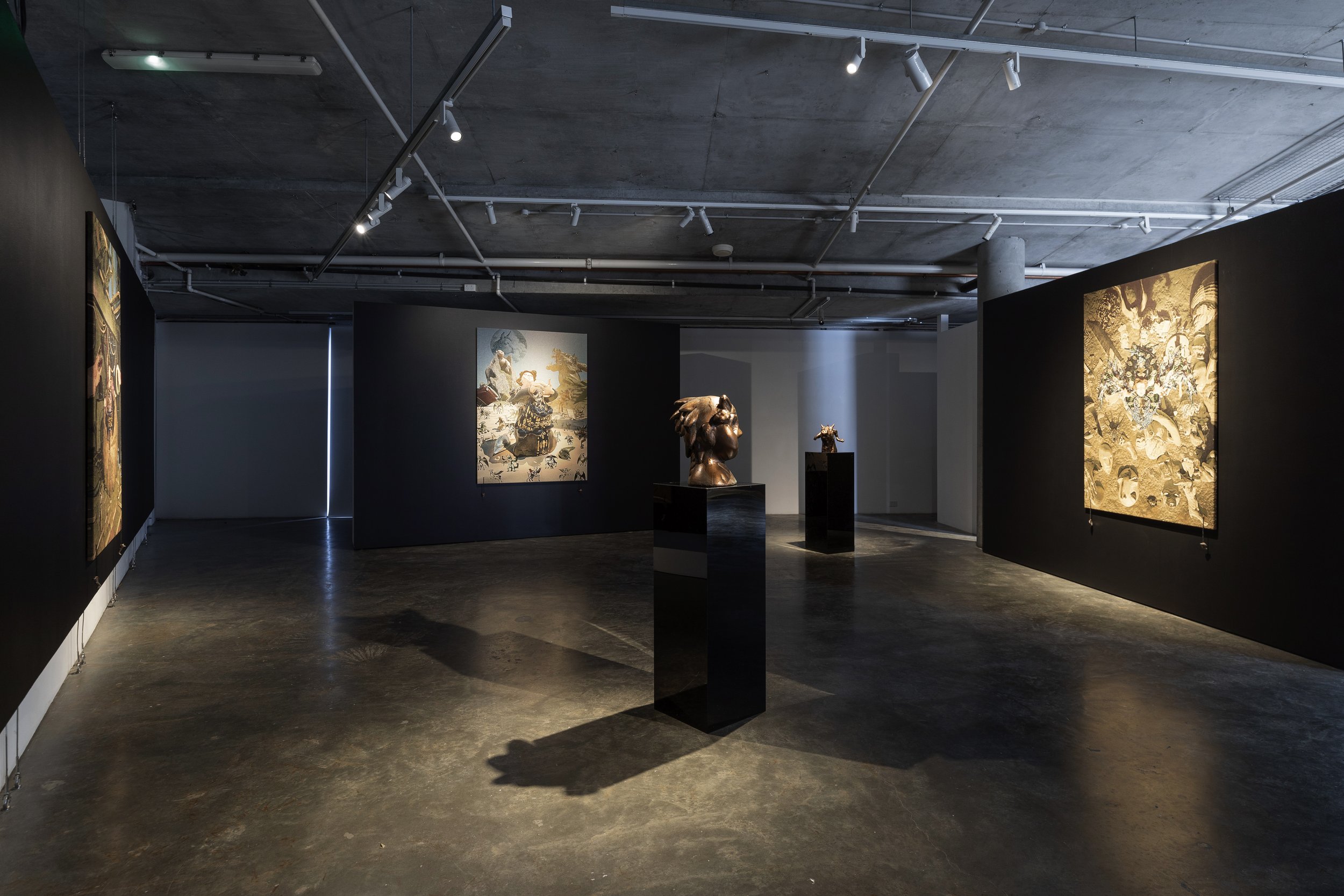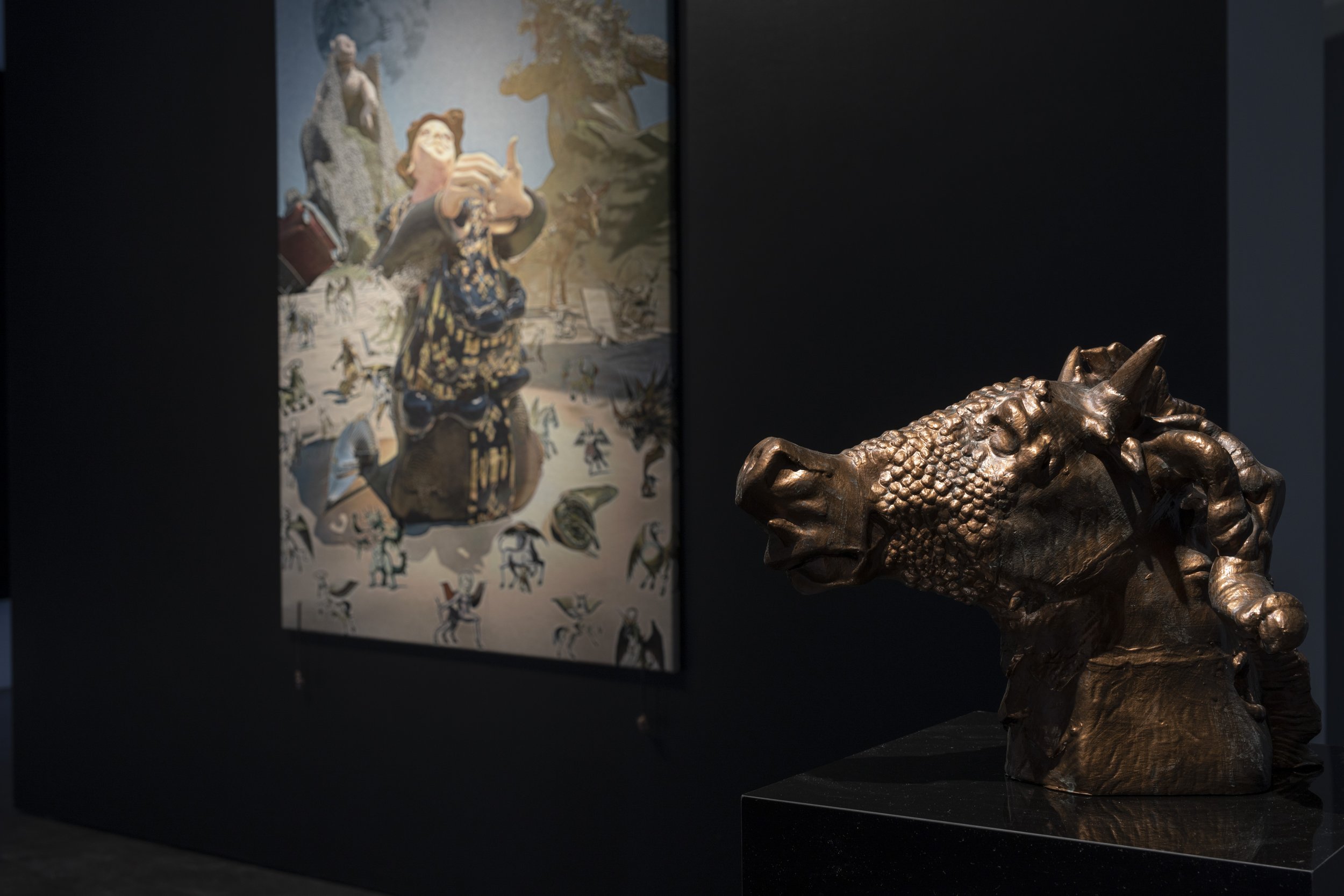NICHOLAS ALOISIO-SHEARER
’FEARLESS SIMPLETON’
24 MAY–23 JUNE
OPENING NIGHT: 1 JUNE
Nicholas Aloisio-Shearer, The Count's Beard, 2023, 3D render. Image courtesy of the artist.
ID: There is a woman in the middle of the image, wearing a purple tunic with brown spots, with a deep purple and gold armour layered on top. The woman is standing in a hollowed out brown rock, with a red liquid pouring over her left shoulder. On either side of the image there are two hands, the left holding a Coca Cola can pouring onto the woman, and the right, holding a golden horseshoe. This image is set in an old wooden house, that is falling apart, with a stone fireplace to the left of the woman.
ARTIST STATEMENT
Fearless Simpleton is an exhibition of tapestries and sculptures which combine the decorative traditions of Sicilian cathedral mosaics, online subcultures, Italian folktales, and the artist's own, misremembered, familial histories. Taking inspiration from his family’s ancestral hometown, the Sicilian “ghost village” Poggioreale, and his grandparents experience of immigration, the artist presents an imagined suite of anachronistic allegories. This convergence of imagery and narratives interrogates how Western art history, imaging technologies, and uncontainable reflections on cultural belonging might make a confrontation with the real too difficult to face.
Nicholas Aloisio-Shearer, Fearless Simpleton, 2023, Installation view. Photography by Jessica Maurer.
ID: The gallery has three canvas’ hung on individual black walls. Each canvas has a 3D image printed onto textiles, the middle one and the one on the right are the only visible images. The image in the middle back, has a woman emerging from a slug like form, with their hands in front of them, with little creatures surrounding her in an apocalyptic desert setting. The image on the right has a women shown from a birds eye view, reaching up. with various sandstone figures around her on the ground. In the middle of the gallery there are two bronze heads on black plinths. The one in the back, is a mystical creature formed of a donkey, dragon and pig. The one at the front is faced side on and has spikey hair that is slicked back, a blank expression.
EXCERPTS FROM TARA HEFFERNAN’S ESSAY
“What are robbers? What are belongings? I am afraid of nothing.”
—the young fool in "The Fearless Simpleton”, a folk tale retold by Italo Calvino.1
Nicholas Aloisio-Shearer borrows the title “Fearless Simpleton” from an Italian folk tale. In this story, a man attempts to instill useful fear into a simple boy, but the young man’s inability to appreciate nuance ends in murder. The tale, demonstrating the unaffected fool’s capacity for ill deeds, poetically sums up the dangers of literalism. It’s rather relevant to our contemporary moment, caught as it is in a media scape buffered by propagandistic reductivism.2 An implied rejection of literalism underlies Aloisio-Shearer’s oeuvre, in which a cacophony of reference points—taken from Western art history, biblical stories, mythology, and Internet subcultures among other sources—come together, revealing the amorphous nature of art and aesthetics and their prostration to ideological tides.
Nicholas Aloisio-Shearer, Fearless Simpleton, 2023, Installation view. Photography by Jessica Maurer.
ID: There is a large canvas in the background, on a black wall. The image depicts a woman emerging from a slug like form, with their hands in front of them, with little creatures surrounding her in an apocalyptic desert setting. In the forefront, there is a bronze head sculpture on a black plinth, faced side on. It looks like a mystical creature with the features of a donkeys head, a pigs nose and the back of a dragons head.
The series of tapestries and sculptural works featured in Fearless Simpleton draw specifically on Aloisio-Shearer’s family history. The artist’s grandparents migrated to Australia from their hometown of Poggioreale in rural Sicily in 1950 and 1961. Scattered with indirect references and aligned iconographic ephemera, the works consider the impact of intergenerational trauma, an investigation sparked by mandatory workplace cultural competency training. Aloisio-Shearer picks at the irreconcilable tensions of cultural inheritance—tensions which cannot be neatly resolved by neoliberal therapeutic methods or symbolic gestures of representational reparation…
Nicholas Aloisio-Shearer, Fearless Simpleton, 2023, Installation view. Photography by Jessica Maurer.
ID: The gallery has two canvas’ hung on individual black walls. Each canvas has a 3D image printed onto textiles. The image on the left, there is a woman in the middle of the image, wearing a purple tunic with brown spots, with a deep purple and gold armour layered on top. The woman is standing in a hollowed out brown rock, with a red liquid pouring over her left shoulder. On either side of the image there are two hands, the left holding a Coca Cola can pouring onto the woman, and the right, holding a golden horseshoe. This image is set in an old wooden house, that is falling apart, with a stone fireplace to the left of the woman. The image on the right, has a woman emerging from a slug like form, with their hands in front of them, with little creatures surrounding her in an apocalyptic desert setting. In the centre of the gallery, there are two bronze heads on black plinths. The one on the right, is a mystical creature formed of a donkey, dragon and pig. The one on the left is faced front on and has three horns on the top of its head, disproportional eyes, and a large hollowed out mouth.
… Aloisio-Shearer doesn’t simply treat history as a dark and unenlightened abyss of moral rigidity and suffering, as many ideologues masquerading as artists do today (indeed, this seems to be the unacknowledged definition of the contemporary artist). And, importantly, he doesn’t pose a binary pitting “the contemporary” against what’s come before. The Internet and its iconographic repository is not treated as a site of utopic, liberatory potential, as it is by a deluge of culture-jamming, accelerationist adherents to cyberfeminist theory and cyberutopianism.
Nicholas Aloisio-Shearer, Fearless Simpleton, 2023, Installation view. Photography by Jessica Maurer.
ID: There is a large canvas in the background, on a black wall. The image depicts a woman emerging from a slug like form, with their hands in front of them, with little creatures surrounding her in an apocalyptic desert setting. In the forefront, there is a bronze head sculpture on a black plinth, faced side on. It looks like a mystical creature with the features of a donkeys head, a pigs nose and the back of a dragons head.
In the introduction to his Italian Folktales (1956), Italo Calvino explained his research process as follows:
"I was gradually possessed by ... an insatiable hunger for more and more versions and variants. Collating, categorising, comparing became a fever. I could feel myself succumbing to a passion akin to that of etymologists ... which rapidly degenerated into a mania."4
Aloisio-Shearer is similarly possessed. His calamitous constellations chart the irreverent terrain forged through—and against the grain of— a heavily surveilled, and accelerated image culture. Echoing the largely unchartable origins of the Italian folklore imprinted in his artworks, it is the community-driven, DIY-hacker corners of the Internet and its cultural debris that Aloisio-Shearer is drawn to and inspired by.5 In this digital Gothic realm, the folkloric art and mythologies of the Internet age can be found.6





